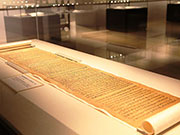The restoration of ancient books in China

 0 Comment(s)
0 Comment(s) Print
Print E-mail CNTV, August 1, 2016
E-mail CNTV, August 1, 2016
The Ministry of Culture launched a preservation project for ancient books in 2007. An essential part of the project has been the cataloguing and restoration of precious texts in a variety of forms, including writings on oracle bones and bamboo sheets.
The current exhibition at the national library has a selection of some of them. These exhibits not only showcase ancient Chinese wisdom but also display the country's latest efforts in restoring ancient books.
Called "national treasures", some 100 ancient books from across the country are exhibited at the National Library.
It is from this ancient Ming Dynasty medical document that Nobel Prize winner Tu Youyou drew inspiration to produce her award-winning anti-malaria medicine.
But what really steals the spotlight are these rare, early examples of block printing......from around the eighth century...
"The biggest significance is that they provide concrete evidence which proves that block printing was invented in China. The restoration has gone through a very complicated process," said Han Yongjin,director, The National Library of China.
The experts tell us, for restoration, the main principle is, actually, "as little restoration as possible".
Because original papers often carry a lot of important information, they should be simply left alone where possible.
Choosing the correct mending materials is also quite a delicate prodecure.
But it's all raised the standard of restoration.
Sometimes the restorers need to make the impossible possible.
"I've been working as a restorer for more than 30 years, but sometimes I get something I've never dealt with before. Just like this scroll, it's very difficult to restore," said Bian Sha, restoration professional.
However, the number of restoration professionals in China, such as Bian Sha, is reaching a critically-low level.
"When the preservation project started in 2007, the number of restoration professionals was fewer than 100 around the country," said Zhang Zhiqing, deputy director, The National Library of China.
"It takes about five years for a student to work independently, and one will then need at least two decades to be a real master."
Zhang said 22 national-level restoration studios have been established across the country, where traditional skills can be passed on to young apprentices.
There are currently about 1,000 restoration professionals in the country.
That's a lot you might say, but there are about 25 million ancient books in need of work around the country.





